Abstract
1. The N-acetylation of dapsone (DDS) was studied in 160 unrelated healthy Jordanian volunteers. 2. The frequency of slow acetylators determined using the plasma monoacetyldapsone (MADDS) to DDS ratio (MADDS/DDS), was 67.5% with a 95% confidence interval of 59 to 76%. Slow acetylators had an acetylation ratio of less than 0.42. 3. Applying the Hardy-Weinberg Law, the frequency of the recessive allele controlling slow acetylation was found to be 0.82 +/- 0.02. 4. The frequency distribution histogram of the plasma MADDS/DDS ratio showed an apparent trimodal pattern. The number of homozygous (n = 16) and heterozygous (n = 36) rapid acetylators derived from the observed data did not agree with those predicted for the respective rapid acetylators (n = 5 and n = 47) according to the Hardy-Weinberg Law. The suggested antimode used to discriminate the two groups was 0.82. 5. The mean plasma concentration of MADDS and the mean plasma acetylation ratio were about three times lower in slow than in rapid acetylators. However, there was no difference in mean plasma DDS concentration between slow and rapid acetylators. 6. There was a significant correlation (r = 0.853, P less than 0.001) between plasma MADDS concentration and the acetylation ratio. For DDS such a correlation was absent (r = 0.059, P = 0.23).
Full text
PDF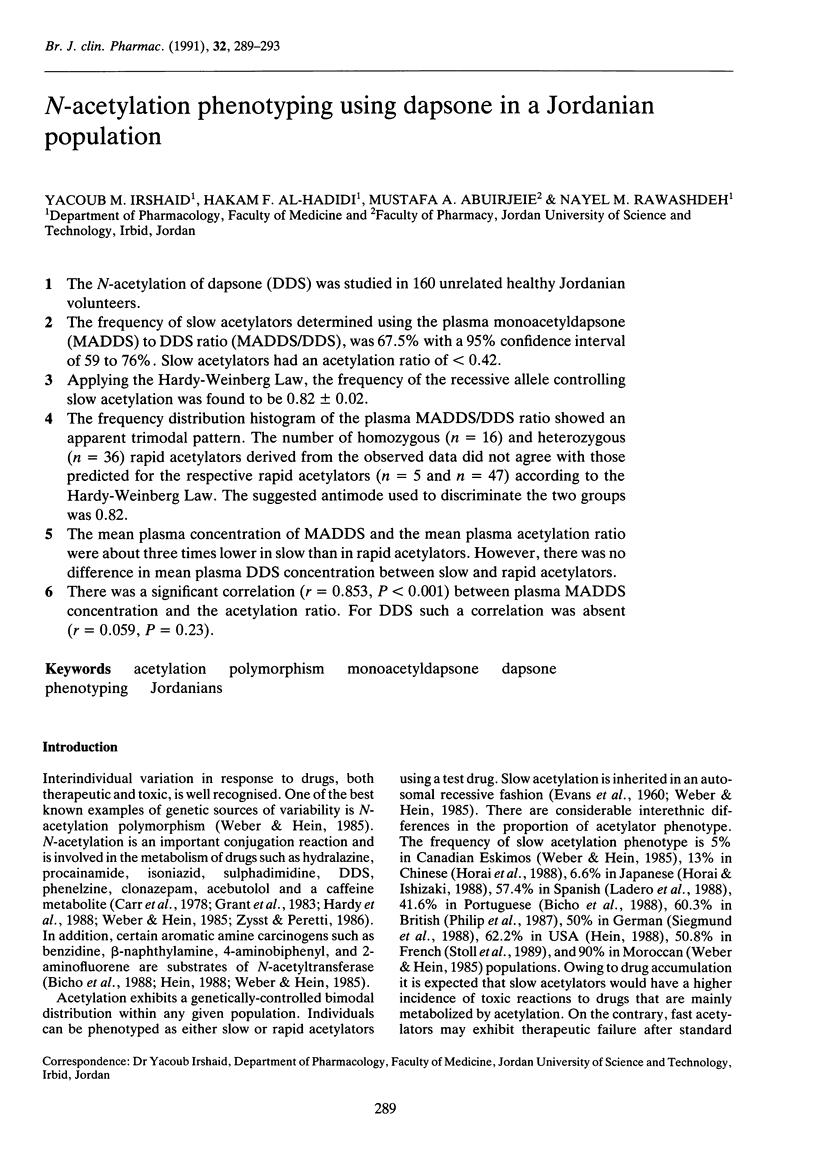
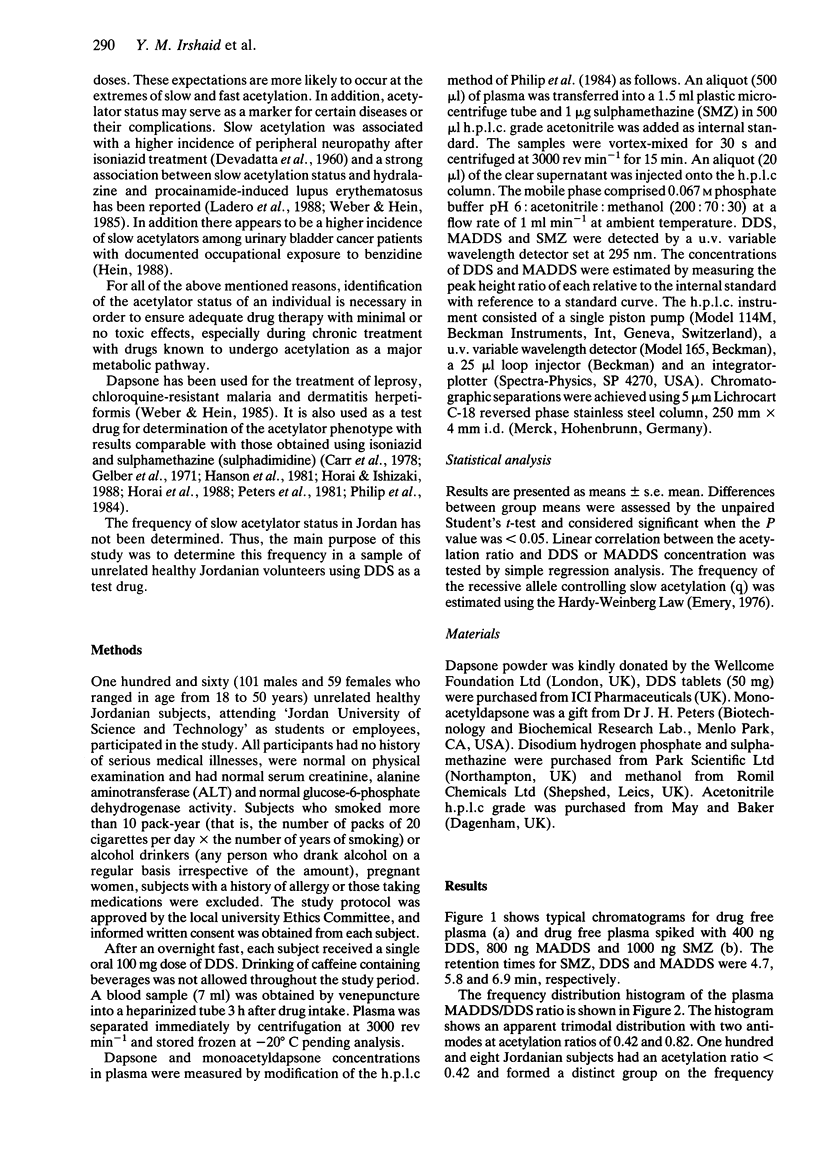
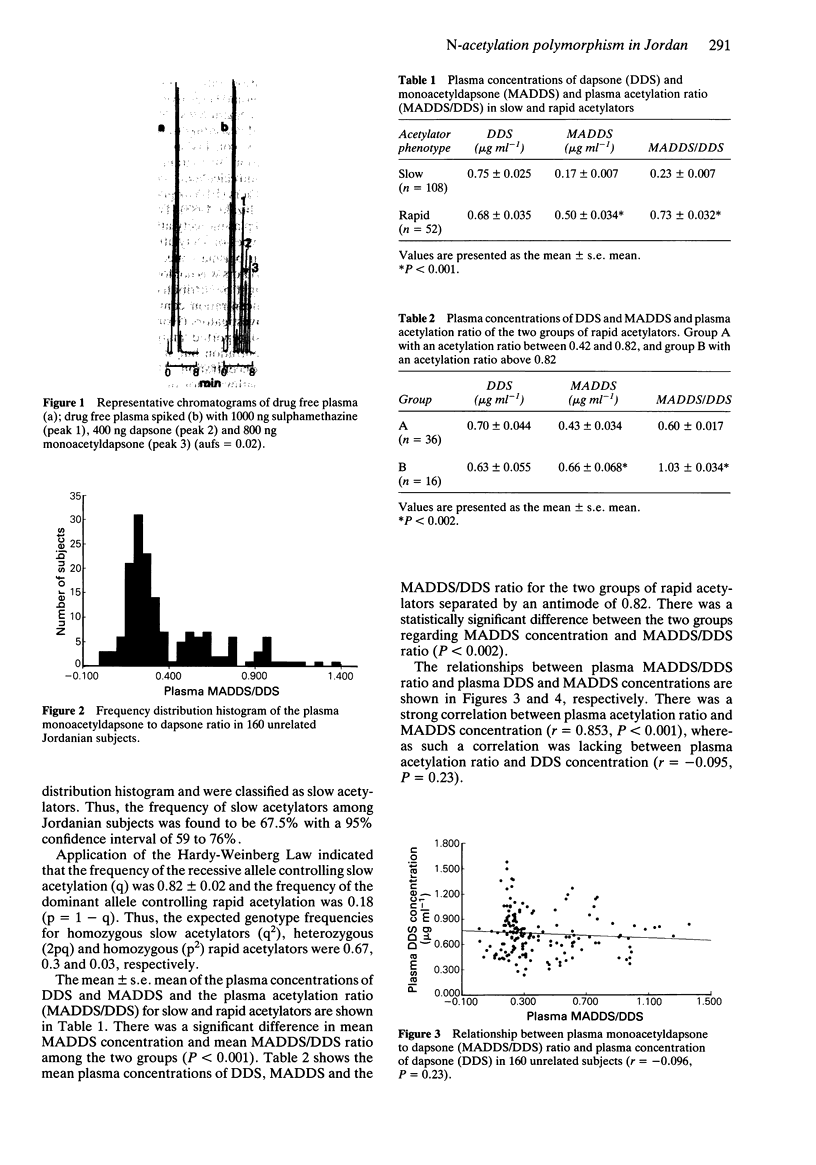
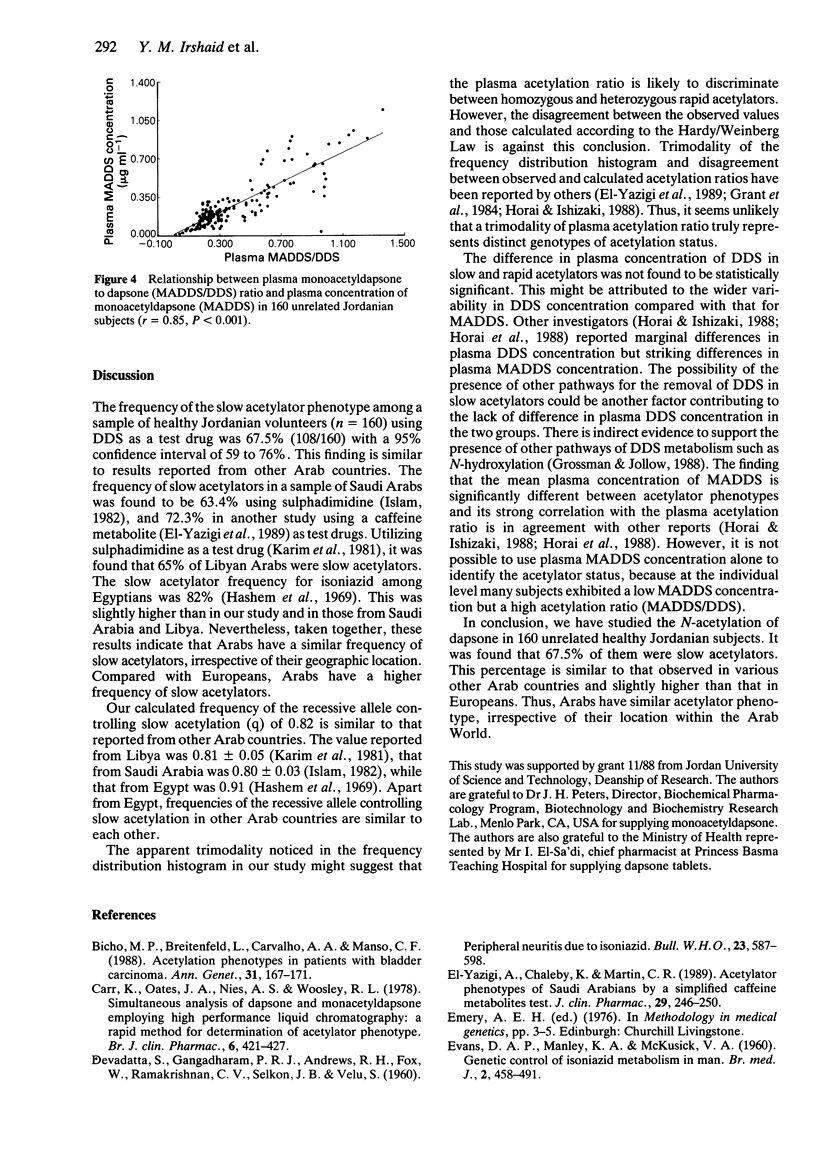
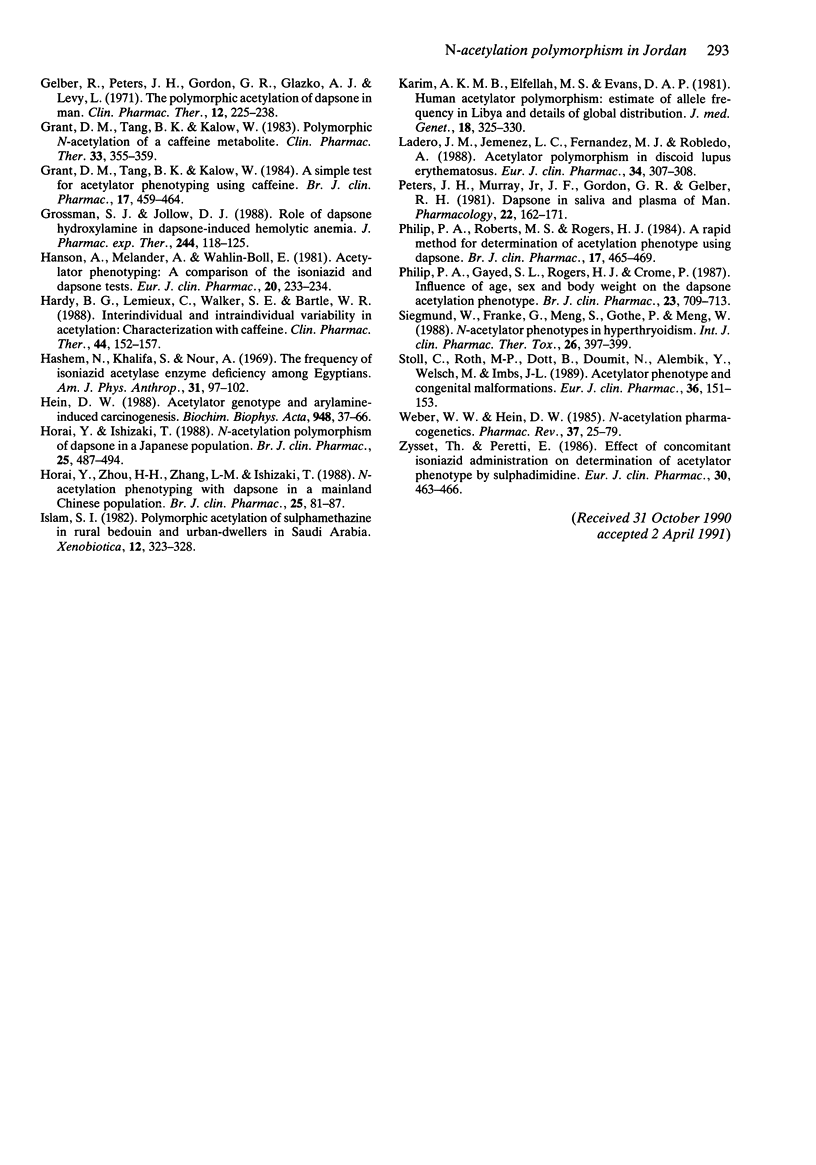
Selected References
These references are in PubMed. This may not be the complete list of references from this article.
- Bicho M. P., Breitenfeld L., Carvalho A. A., Manso C. F. Acetylation phenotypes in patients with bladder carcinoma. Ann Genet. 1988;31(3):167–171. [PubMed] [Google Scholar]
- Carr K., Oates J. A., Nies A. S., Woosley R. L. Simultaneous analysis of dapsone and monoacetyldapsone employing high performance liquid chromatography: a rapid method for determination of acetylator phenotype. Br J Clin Pharmacol. 1978 Nov;6(5):421–427. doi: 10.1111/j.1365-2125.1978.tb04606.x. [DOI] [PMC free article] [PubMed] [Google Scholar]
- DEVADATTA S., GANGADHARAM P. R., ANDREWS R. H., FOX W., RAMAKRISHNAN C. V., SELKON J. B., VELU S. Peripheral neuritis due to isoniazid. Bull World Health Organ. 1960;23:587–598. [PMC free article] [PubMed] [Google Scholar]
- EVANS D. A., MANLEY K. A., McKUSICK V. A. Genetic control of isoniazid metabolism in man. Br Med J. 1960 Aug 13;2(5197):485–491. doi: 10.1136/bmj.2.5197.485. [DOI] [PMC free article] [PubMed] [Google Scholar]
- Gelber R., Peters J. H., Gordon G. R., Glazko A. J., Levy L. The polymorphic acetylation of dapsone in man. Clin Pharmacol Ther. 1971 Mar-Apr;12(2):225–238. doi: 10.1002/cpt1971122part1225. [DOI] [PubMed] [Google Scholar]
- Grant D. M., Tang B. K., Kalow W. A simple test for acetylator phenotype using caffeine. Br J Clin Pharmacol. 1984 Apr;17(4):459–464. doi: 10.1111/j.1365-2125.1984.tb02372.x. [DOI] [PMC free article] [PubMed] [Google Scholar]
- Grant D. M., Tang B. K., Kalow W. Polymorphic N-acetylation of a caffeine metabolite. Clin Pharmacol Ther. 1983 Mar;33(3):355–359. doi: 10.1038/clpt.1983.45. [DOI] [PubMed] [Google Scholar]
- Grossman S. J., Jollow D. J. Role of dapsone hydroxylamine in dapsone-induced hemolytic anemia. J Pharmacol Exp Ther. 1988 Jan;244(1):118–125. [PubMed] [Google Scholar]
- Hanson A., Melander A., Wåhlin-Boll E. Acetylator phenotyping: a comparison of the isoniazid and dapsone tests. Eur J Clin Pharmacol. 1981;20(3):233–234. doi: 10.1007/BF00544604. [DOI] [PubMed] [Google Scholar]
- Hardy B. G., Lemieux C., Walker S. E., Bartle W. R. Interindividual and intraindividual variability in acetylation: characterization with caffeine. Clin Pharmacol Ther. 1988 Aug;44(2):152–157. doi: 10.1038/clpt.1988.130. [DOI] [PubMed] [Google Scholar]
- Hashem N., Khalifa S., Nour A. The frequency of isoniazid acetylase enzyme deficiency among Egyptians. Am J Phys Anthropol. 1969 Jul;31(1):97–101. doi: 10.1002/ajpa.1330310114. [DOI] [PubMed] [Google Scholar]
- Hein D. W. Acetylator genotype and arylamine-induced carcinogenesis. Biochim Biophys Acta. 1988 Aug 3;948(1):37–66. doi: 10.1016/0304-419x(88)90004-2. [DOI] [PubMed] [Google Scholar]
- Horai Y., Ishizaki T. N-acetylation polymorphism of dapsone in a Japanese population. Br J Clin Pharmacol. 1988 Apr;25(4):487–494. doi: 10.1111/j.1365-2125.1988.tb03333.x. [DOI] [PMC free article] [PubMed] [Google Scholar]
- Horai Y., Zhou H. H., Zhang L. M., Ishizaki T. N-acetylation phenotyping with dapsone in a mainland Chinese population. Br J Clin Pharmacol. 1988 Jan;25(1):81–87. doi: 10.1111/j.1365-2125.1988.tb03285.x. [DOI] [PMC free article] [PubMed] [Google Scholar]
- Islam S. I. Polymorphic acetylation of sulphamethazine in rural bedouin and urban-dwellers in Saudi Arabia. Xenobiotica. 1982 May;12(5):323–328. doi: 10.3109/00498258209052472. [DOI] [PubMed] [Google Scholar]
- Karim A. K., Elfellah M. S., Evans D. A. Human acetylator polymorphism: estimate of allele frequency in Libya and details of global distribution. J Med Genet. 1981 Oct;18(5):325–330. doi: 10.1136/jmg.18.5.325. [DOI] [PMC free article] [PubMed] [Google Scholar]
- Ladero J. M., Jiménez L. C., Fernández M. J., Robledo A. Acetylator polymorphism in discoid lupus erythematosus. Eur J Clin Pharmacol. 1988;34(3):307–308. doi: 10.1007/BF00540961. [DOI] [PubMed] [Google Scholar]
- Peters J. H., Murray J. F., Jr, Gordon G. R., Gelber R. H. Dapsone in saliva and plasma of man. Pharmacology. 1981;22(3):162–171. doi: 10.1159/000137486. [DOI] [PubMed] [Google Scholar]
- Philip P. A., Gayed S. L., Rogers H. J., Crome P. Influence of age, sex and body weight on the dapsone acetylation phenotype. Br J Clin Pharmacol. 1987 Jun;23(6):709–713. doi: 10.1111/j.1365-2125.1987.tb03105.x. [DOI] [PMC free article] [PubMed] [Google Scholar]
- Philip P. A., Roberts M. S., Rogers H. J. A rapid method for determination of acetylation phenotype using dapsone. Br J Clin Pharmacol. 1984 Apr;17(4):465–469. doi: 10.1111/j.1365-2125.1984.tb02373.x. [DOI] [PMC free article] [PubMed] [Google Scholar]
- Siegmund W., Franke G., Meng S., Gothe P., Meng W. N-acetylator phenotypes in hyperthyroidism. Int J Clin Pharmacol Ther Toxicol. 1988 Aug;26(8):397–399. [PubMed] [Google Scholar]
- Stoll C., Roth M. P., Dott B., Doumit N., Alembik Y., Welsch M., Imbs J. L. Acetylator phenotype and congenital malformations. Eur J Clin Pharmacol. 1989;36(2):151–153. doi: 10.1007/BF00609187. [DOI] [PubMed] [Google Scholar]
- Weber W. W., Hein D. W. N-acetylation pharmacogenetics. Pharmacol Rev. 1985 Mar;37(1):25–79. [PubMed] [Google Scholar]
- Zysset T., Peretti E. Effect of concomitant isoniazid administration on determination of acetylator phenotype by sulphadimidine. Eur J Clin Pharmacol. 1986;30(4):463–466. doi: 10.1007/BF00607961. [DOI] [PubMed] [Google Scholar]
- el-Yazigi A., Chaleby K., Martin C. R. Acetylator phenotypes of Saudi Arabians by a simplified caffeine metabolites test. J Clin Pharmacol. 1989 Mar;29(3):246–250. doi: 10.1002/j.1552-4604.1989.tb03321.x. [DOI] [PubMed] [Google Scholar]


